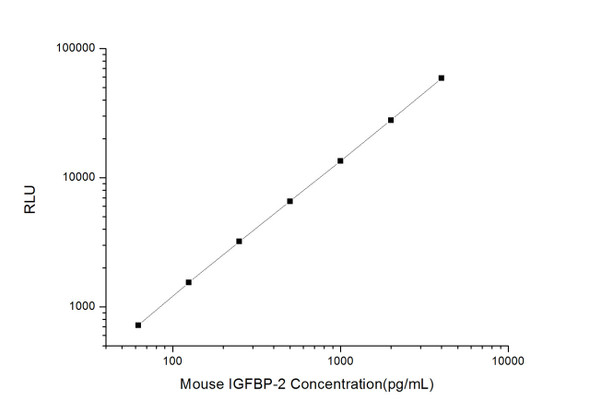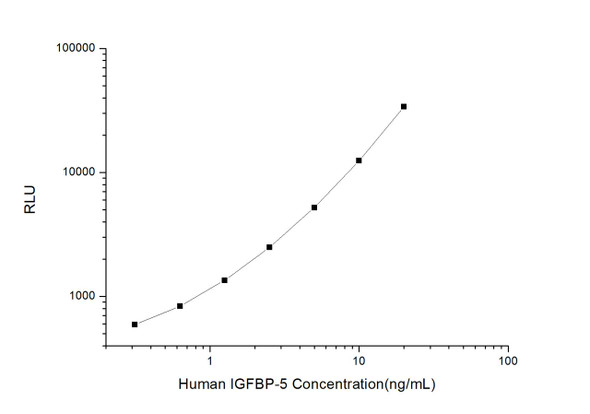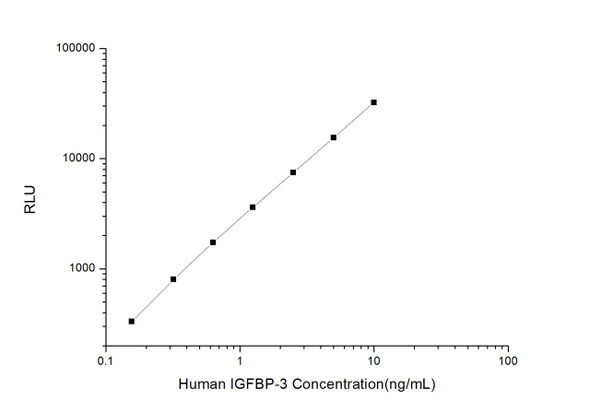Human Developmental Biology ELISA Kits
Human IGFBP-2 (Insulin Like Growth Factor Binding Protein 2) CLIA Kit (HUES00322)
- SKU:
- HUES00322
- Product Type:
- ELISA Kit
- ELISA Type:
- CLIA Kit
- Size:
- 96 Assays
- Sensitivity:
- 37.5pg/mL
- Range:
- 62.5-4000pg/mL
- ELISA Type:
- Sandwich
- Synonyms:
- IGFBP2, IBP2, IGF-BP53
- Reactivity:
- Human
- Sample Type:
- Serum, plasma and other biological fluids
- Research Area:
- Developmental Biology
Description
| Assay type: | Sandwich |
| Format: | 96T |
| Assay time: | 4.5h |
| Reactivity: | Human |
| Detection method: | Chemiluminescence |
| Detection range: | 62.50-4000 pg/mL |
| Sensitivity: | 37.50 pg/mL |
| Sample volume: | 100µL |
| Sample type: | Serum, plasma and other biological fluids |
| Repeatability: | CV < 15% |
| Specificity: | This kit recognizes Human IGFBP-2 in samples. No significant cross-reactivity or interference between Human IGFBP-2 and analogues was observed. |
This kit uses Sandwich-CLIA as the method. The micro CLIA plate provided in this kit has been pre-coated with an antibody specific to Human IGFBP-2. Standards or samples are added to the appropriate micro CLIA plate wells and combined with the specific antibody. Then a biotinylated detection antibody specific for Human IGFBP-2 and Avidin-Horseradish Peroxidase (HRP) conjugate are added to each micro plate well successively and incubated. Free components are washed away. The substrate solution is added to each well. Only those wells that contain Human IGFBP-2, biotinylated detection antibody and Avidin-HRP conjugate will appear fluorescence. The Relative light unit (RLU) value is measured spectrophotometrically by the Chemiluminescence immunoassay analyzer. The RLU value is positively associated with the concentration of Human IGFBP-2. The concentration of Human IGFBP-2 in the samples can be calculated by comparing the RLU of the samples to the standard curve.
| UniProt Protein Function: | IGFBP2: Inhibits IGF-mediated growth and developmental rates. IGF-binding proteins prolong the half-life of the IGFs and have been shown to either inhibit or stimulate the growth promoting effects of the IGFs on cell culture. They alter the interaction of IGFs with their cell surface receptors. Binds IGF2 more than IGF1. |
| UniProt Protein Details: | Protein type:Secreted; Secreted, signal peptide Chromosomal Location of Human Ortholog: 2q35 Cellular Component: extracellular space; apical plasma membrane; extracellular region; cytoplasmic vesicle Molecular Function:protein binding; insulin-like growth factor I binding; insulin-like growth factor II binding Biological Process: response to drug; regulation of insulin-like growth factor receptor signaling pathway; response to retinoic acid; response to lithium ion; response to glucocorticoid stimulus; female pregnancy; positive regulation of activated T cell proliferation; signal transduction; response to estradiol stimulus; cellular response to hormone stimulus; cellular protein metabolic process; response to mechanical stimulus; regulation of cell growth; response to nutrient; aging |
| UniProt Code: | P18065 |
| NCBI GenInfo Identifier: | 290457647 |
| NCBI Gene ID: | 3485 |
| NCBI Accession: | P18065. 2 |
| UniProt Secondary Accession: | P18065,Q14619, Q9UCL3, |
| UniProt Related Accession: | P18065 |
| Molecular Weight: | 34,814 Da |
| NCBI Full Name: | Insulin-like growth factor-binding protein 2 |
| NCBI Synonym Full Names: | insulin-like growth factor binding protein 2, 36kDa |
| NCBI Official Symbol: | IGFBP2 |
| NCBI Official Synonym Symbols: | IBP2; IGF-BP53 |
| NCBI Protein Information: | insulin-like growth factor-binding protein 2; IBP-2; IGFBP-2; IGF-binding protein 2 |
| UniProt Protein Name: | Insulin-like growth factor-binding protein 2 |
| Protein Family: | Insulin-like growth factor-binding protein |
| UniProt Gene Name: | IGFBP2 |
| UniProt Entry Name: | IBP2_HUMAN |
As the RLU values of the standard curve may vary according to the conditions of the actual assay performance (e. g. operator, pipetting technique, washing technique or temperature effects), the operator should establish a standard curve for each test. Typical standard curve and data is provided below for reference only.
| Concentration (pg/mL) | RLU | Average | Corrected |
| 4000 | 54896 63266 | 59081 | 59046 |
| 2000 | 27849 27869 | 27859 | 27824 |
| 1000 | 14294 12674 | 13484 | 13449 |
| 500 | 6240 6970 | 6605 | 6570 |
| 250 | 3402 3084 | 3243 | 3208 |
| 125 | 1644 1518 | 1581 | 1546 |
| 62.50 | 745 765 | 755 | 720 |
| 0 | 34 36 | 35 | -- |
Precision
Intra-assay Precision (Precision within an assay): 3 samples with low, mid range and high level Human IGFBP-2 were tested 20 times on one plate, respectively.
Inter-assay Precision (Precision between assays): 3 samples with low, mid range and high level Human IGFBP-2 were tested on 3 different plates, 20 replicates in each plate.
| Intra-assay Precision | Inter-assay Precision | |||||
| Sample | 1 | 2 | 3 | 1 | 2 | 3 |
| n | 20 | 20 | 20 | 20 | 20 | 20 |
| Mean (pg/mL) | 211.13 | 412.64 | 1492.96 | 220.83 | 445.97 | 1425.37 |
| Standard deviation | 26.94 | 30.82 | 157.21 | 24.34 | 44.51 | 98.35 |
| C V (%) | 12.76 | 7.47 | 10.53 | 11.02 | 9.98 | 6.90 |
Recovery
The recovery of Human IGFBP-2 spiked at three different levels in samples throughout the range of the assay was evaluated in various matrices.
| Sample Type | Range (%) | Average Recovery (%) |
| Serum (n=5) | 102-114 | 107 |
| EDTA plasma (n=5) | 93-108 | 100 |
| Cell culture media (n=5) | 88-99 | 94 |
Linearity
Samples were spiked with high concentrations of Human IGFBP-2 and diluted with Reference Standard & Sample Diluent to produce samples with values within the range of the assay.
| Serum (n=5) | EDTA plasma (n=5) | Cell culture media (n=5) | ||
| 1:2 | Range (%) | 87-99 | 100-114 | 100-119 |
| Average (%) | 94 | 105 | 109 | |
| 1:4 | Range (%) | 100-117 | 91-108 | 103-116 |
| Average (%) | 108 | 99 | 110 | |
| 1:8 | Range (%) | 91-102 | 102-116 | 100-118 |
| Average (%) | 97 | 108 | 109 | |
| 1:16 | Range (%) | 92-107 | 102-117 | 95-106 |
| Average (%) | 99 | 109 | 101 |
An unopened kit can be stored at 4°C for 1 month. If the kit is not used within 1 month, store the items separately according to the following conditions once the kit is received.
| Item | Specifications | Storage |
| Micro CLIA Plate(Dismountable) | 8 wells ×12 strips | -20°C, 6 months |
| Reference Standard | 2 vials | |
| Concentrated Biotinylated Detection Ab (100×) | 1 vial, 120 µL | |
| Concentrated HRP Conjugate (100×) | 1 vial, 120 µL | -20°C(shading light), 6 months |
| Reference Standard & Sample Diluent | 1 vial, 20 mL | 4°C, 6 months |
| Biotinylated Detection Ab Diluent | 1 vial, 14 mL | |
| HRP Conjugate Diluent | 1 vial, 14 mL | |
| Concentrated Wash Buffer (25×) | 1 vial, 30 mL | |
| Substrate Reagent A | 1 vial, 5 mL | 4°C (shading light) |
| Substrate Reagent B | 1 vial, 5 mL | 4°C (shading light) |
| Plate Sealer | 5 pieces | |
| Product Description | 1 copy | |
| Certificate of Analysis | 1 copy |
- Set standard, test sample and control (zero) wells on the pre-coated plate and record theirpositions. It is recommended to measure each standard and sample in duplicate. Note: addall solutions to the bottom of the plate wells while avoiding contact with the well walls. Ensuresolutions do not foam when adding to the wells.
- Aliquot 100µl of standard solutions into the standard wells.
- Add 100µl of Sample / Standard dilution buffer into the control (zero) well.
- Add 100µl of properly diluted sample (serum, plasma, tissue homogenates and otherbiological fluids. ) into test sample wells.
- Cover the plate with the sealer provided in the kit and incubate for 90 min at 37°C.
- Aspirate the liquid from each well, do not wash. Immediately add 100µL of BiotinylatedDetection Ab working solution to each well. Cover the plate with a plate seal and gently mix. Incubate for 1 hour at 37°C.
- Aspirate or decant the solution from the plate and add 350µL of wash buffer to each welland incubate for 1-2 minutes at room temperature. Aspirate the solution from each well andclap the plate on absorbent filter paper to dry. Repeat this process 3 times. Note: a microplatewasher can be used in this step and other wash steps.
- Add 100µL of HRP Conjugate working solution to each well. Cover with a plate seal andincubate for 30 min at 37°C.
- Aspirate or decant the solution from each well. Repeat the wash process for five times asconducted in step 7.
- Add 100µL of Substrate mixture solution to each well. Cover with a new plate seal andincubate for no more than 5 min at 37°C. Protect the plate from light.
- Determine the RLU value of each well immediately.






